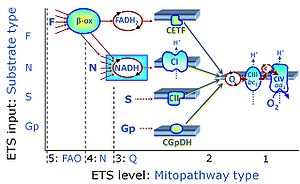Difference between revisions of "Convergent electron flow"
(Redirected page to Additive effect of convergent NS-electron flow) |
|||
| (6 intermediate revisions by 2 users not shown) | |||
| Line 1: | Line 1: | ||
{{MitoPedia | |||
|abbr=n.a. | |||
|description=[[Image:SUIT-catg_FNSGp.jpg|right|300px|Convergent electron flow]] | |||
'''Convergent electron flow''' is built into the metabolic design of the [[Electron transfer pathway]]. The glycolytic pathways are characterized by important ''divergent branchpoints'': phosphoenolpyruvate (PEPCK) branchpoint to pyruvate or oxaloactetate; pyruvate branchpoint to (aerobic) acetyl-CoA or (anaerobic) lactate or alanine. The mitochondrial Electron transfer pathway, in contrast, is characterized by ''convergent junctions'': (1) the [[N-junction]] and [[F-junction]] in the [[mitochondrial matrix]] at ET-pathway level 4, with dehydrogenases (including the TCA cycle) and ß-oxidation generating NADH and FADH<sub>2</sub> as substrates for [[Complex I]] and [[electron-transferring flavoprotein complex]], respectively, and (2) the [[Q-junction]] with inner mt-membrane respiratory complexes at ET-pathway level 3, reducing the oxidized ubiquinone and partially reduced semiquinone to the fully reduced ubiquinol, feeding electrons into [[Complex III]]. | |||
|info=[[Gnaiger 2020 BEC MitoPathways]], [[Gnaiger_2009_Int J Biochem Cell Biol]] | |||
}} | |||
::: ''More details'' | |||
::::» [[Additive effect of convergent electron flow]] | |||
::::» [[Respiratory_complexes#Respiratory_complexes_-_more_than_five |Respiratory complexes - more than five]] | |||
{{MitoPedia methods | |||
|mitopedia method=Respirometry | |||
}} | |||
{{MitoPedia topics | |||
|mitopedia topic=Substrate and metabolite | |||
}} | |||
Latest revision as of 19:47, 1 January 2021
Description
Convergent electron flow is built into the metabolic design of the Electron transfer pathway. The glycolytic pathways are characterized by important divergent branchpoints: phosphoenolpyruvate (PEPCK) branchpoint to pyruvate or oxaloactetate; pyruvate branchpoint to (aerobic) acetyl-CoA or (anaerobic) lactate or alanine. The mitochondrial Electron transfer pathway, in contrast, is characterized by convergent junctions: (1) the N-junction and F-junction in the mitochondrial matrix at ET-pathway level 4, with dehydrogenases (including the TCA cycle) and ß-oxidation generating NADH and FADH2 as substrates for Complex I and electron-transferring flavoprotein complex, respectively, and (2) the Q-junction with inner mt-membrane respiratory complexes at ET-pathway level 3, reducing the oxidized ubiquinone and partially reduced semiquinone to the fully reduced ubiquinol, feeding electrons into Complex III.
Abbreviation: n.a.
Reference: Gnaiger 2020 BEC MitoPathways, Gnaiger_2009_Int J Biochem Cell Biol
MitoPedia methods:
Respirometry
MitoPedia topics:
Substrate and metabolite

